Name Santísima Trinidad Laid down 11 October 1971 Out of service 1989 Launched 9 November 1974 Weight 4,166 tons Builder Río Santiago Shipyard | Ordered 18 May 1970 Commissioned 1 July 1981 Construction started 11 October 1971 Length 125 m Draft 5.2 m | |
 | ||
Namesake After a brigantine commanded by Admiral Guillermo Brown in 1815 | ||
Ara sant sima trinidad d 2
ARA Santísima Trinidad is a Type 42 destroyer of the Argentine Navy, the only one of her class built outside Britain. She participated in the 1982 Falklands War. From January 2013 to December 2015, the warship was lying on her side, sunk at her moorings in the Argentine naval base of Puerto Belgrano for lack of maintenance. She was refloated and the navy plans to turn her into a museum ship.
Contents
- Ara sant sima trinidad d 2
- Construction and trials
- Sabotage
- Commissioning
- Argentine Landings
- Sea Harrier incident
- Coastal surveillance
- After the war
- Fate
- References

Construction and trials
The destroyer was built at the Argentine AFNE Río Santiago shipyard and commissioned in 1980.
Sabotage

Construction began in 1973, but commissioning was long delayed by an improvised limpet mine attack carried out by divers of the guerrilla organization Montoneros on 22 August 1975. The date was chosen as a retaliation for the Trelew massacre three years before, when a number of leftist militants, most of them from the People's Revolutionary Army (ERP), were executed inside Almirante Zar air base, operated by the navy. The raid was allegedly planned in imitation of Operation Frankton, a British commando attack against German shipping in Bordeaux during World War II. The attack involved the use of a folding boat, frogmen and a limpet mine with 375 lb (170 kg) of explosives, which was laid on the river bed below the destroyer after a failed attempt to attach the device to the hull. The ship's bottom and electronics suffered severe damage, and completion was suspended for a year as a result of the attack.
Commissioning
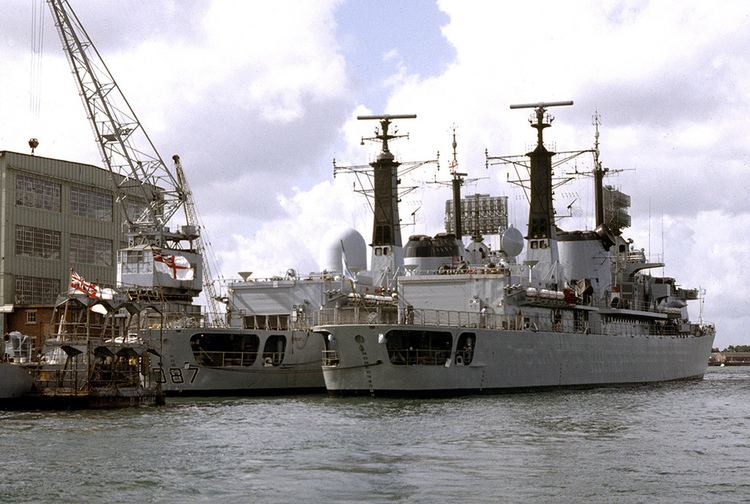
The Argentine Navy enhanced the offensive capabilities of their Type 42s by fitting MM-38 Exocet missiles. The boat decks of the original design were replaced by special decks to install the missiles around the funnel, but the launchers were apparently never mounted on Santísima Trinidad. In November 1981 she made her maiden voyage to Britain, where the destroyer carried out her first sea trials, and her crew was trained in the operation and launching of Sea Dart missiles.
Argentine Landings
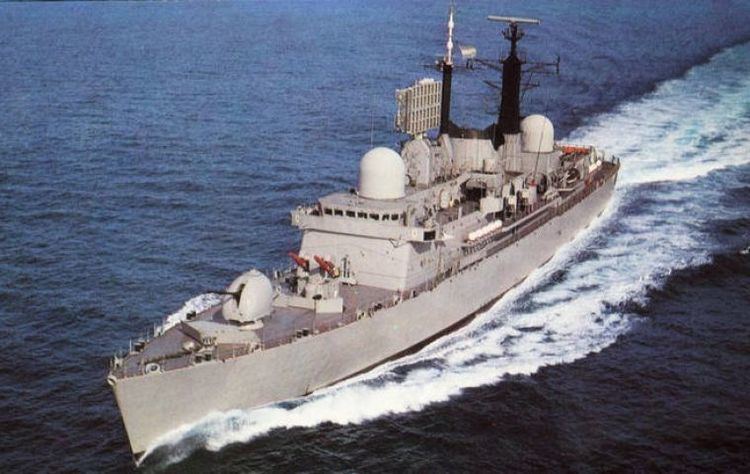
Santísima Trinidad was the leading ship of the Argentine landings on the Falklands on 2 April 1982. Both the navy and the army commanders of the operation were on board. A team of 84 amphibious commandos and 8 tactical divers landed at Mullet Creek at midnight in 21 Gemini boats lowered from her deck. The wireless message asking the surrender of the British Governor and the Marines detachment was also radioed from the destroyer.
Sea Harrier incident

During the remainder of the Falklands War, along with her sister ship Hércules, the unit served as the main escort to the aircraft carrier Veinticinco de Mayo. At first Hércules operated independently along with a group of older destroyers, but the development of mechanical problems in her sister ship forced the Argentine commander to merge the two Type 42 destroyers into one escorting force. The carrier naval group was known as Grupo de Tareas 79.1 (task force 79.1), and was intended to search for and engage its British counterpart from waters north of the Falklands. Santísima Trinidad was responsible for the command and control of the group's air defence.
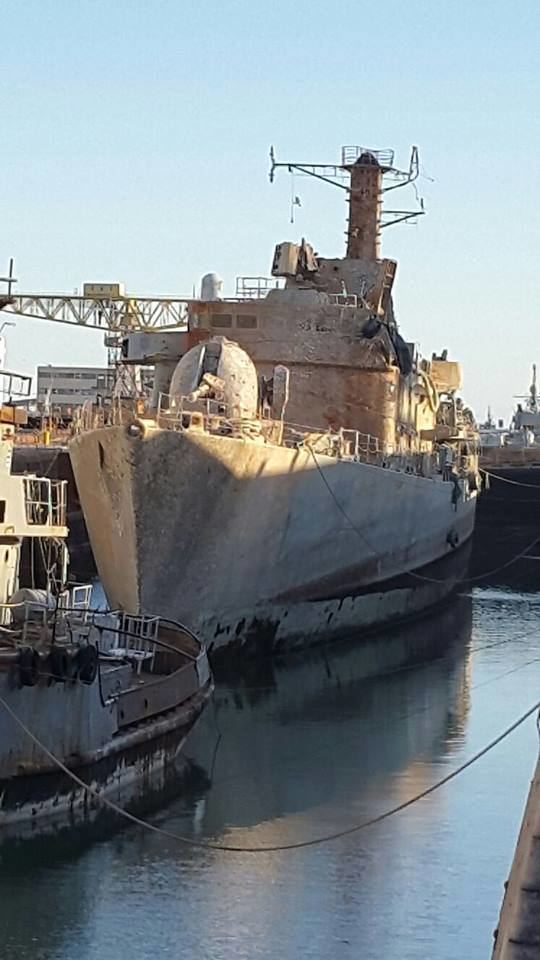
Late on 1 May, the carrier launched a number of S-2 Tracker surveillance aircraft, with the aim of finding the British Task Group. One of the Tracker's crews radioed that they were being chased by an unknown jet while returning to Veinticinco de Mayo. Shortly after midnight, Santísima Trinidad was ordered to switch her Type 965 radar on and track the unidentified contact. She then locked up a Sea Harrier with her Type 909 fire-control radar, followed afterwards by her sister Hércules. The British aircraft, Sea Harrier XZ451 piloted by Flight Lieutenant Ian Mortimer and belonging to the 801 Naval Air Squadron, was fended off by the threat of the Sea Dart, but not before spotting the area of deployment of the Argentine fleet. After realising that the enemy was not engaged in a major amphibious operation as supposed, which made any attempt of the Argentine against the British carriers extremely dangerous, the Argentine commander, Admiral Allara, decided to withdraw his forces to shallow waters close to the coast.
Coastal surveillance
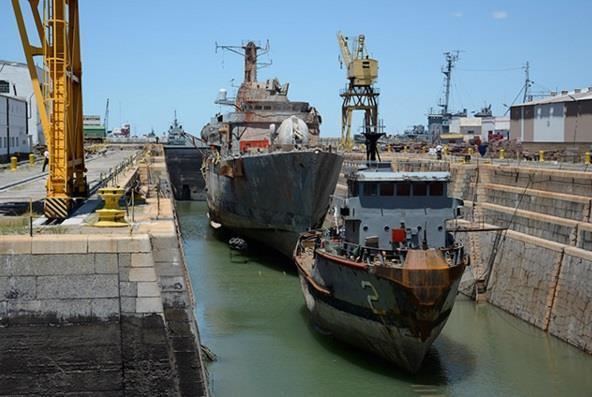
The destroyer lost her Lynx helicopter on 4 May when the aircraft hit her flight-deck as the Argentine fleet was redeploying. She spent the next few days in dry dock to repair the mechanical problems which reduced her speed during the operations of 1 May. in the following weeks, Santísima Trinidad was engaged in patrol duties off Patagonia. During the Air Force attacks on Bluff Cove on 8 June, Santísima Trinidad played a key role by jamming the frequencies used by the Sea Harriers air controllers with interference signals. Once the end of hostilities was declared, Santísima Trinidad escorted the British transport Canberra into Puerto Madryn with about 3,000 Argentine prisoners on board.
After the war
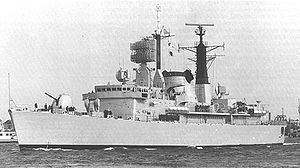
After the war the British weapons and supplies embargo on Argentina made the purchase of spare parts impossible. The Argentine Minister of Defence considered selling the destroyers, and as a consequence, the Navy placed Santísima Trinidad in reserve as a parts supplier for Hércules. From 2 to 15 March 1987 she took part in Operation Grifo, the Argentine response to Operation Fire-Focus, the largest British military exercise around the Falklands since 1982. Her last Sea Dart missile test launch was conducted on 27 November 1987 against an Argentine-built drone. Santísima Trinidad's last voyage took place in 1989.
Fate
Since 2004, Santísima Trinidad was listed as "in reserve awaiting overhaul", but it was expected that the navy would formally decommission her. There were projects in the Argentine congress calling for Santísima Trinidad to be converted into a museum ship.
On 21 January 2013, Santísima Trinidad suffered a broken valve which resulted in the flooding of several compartments. The flooding was beyond the capacity of the pumps and the crew was evacuated. The ship took on a 50-degree list and sank at her moorings. Santísima Trinidad was in poor condition before she sank; the ship had been cannibalized to keep her sister Hércules operational, as the British refused to sell the Argentines spare parts after the Falklands War. In September 2014, specialists of the Argentine navy began an operation to raise the ship. In December 2015, Santísima Trinidad was refloated and the Navy announced they plan to turn her into a museum dedicated to the 1982 war.
